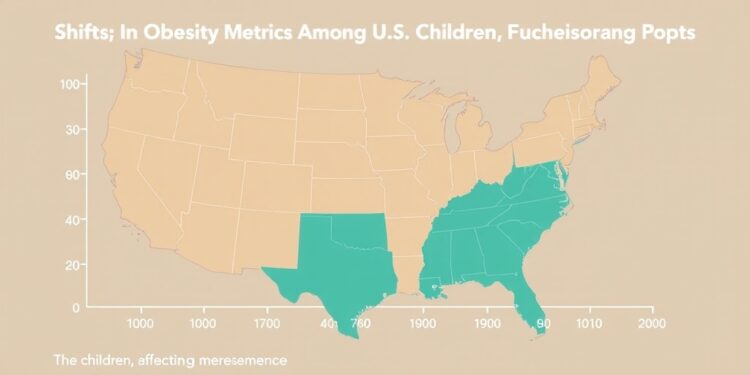The obesity epidemic in the United States has been a persistent public health concern, with its prevalence affecting children, adolescents, and adults alike. A comprehensive study conducted from 2013-2014 to August 2021-2023 highlights notable trends in obesity rates during this period, particularly emphasizing the small increases observed in the percentages of children and adolescents grappling with obesity and adults experiencing severe obesity. While the overall obesity percentage for adults remained stagnant, the findings prompt an urgent dialogue surrounding the multifaceted causes and implications of weight gain observed during and after the COVID-19 pandemic.
This recent study leverages electronic health records, providing significant insights into mean weight changes among adults during the pandemic years. Such data is critical, considering that the COVID-19 pandemic has disrupted lifestyles, eating habits, and access to physical activity, potentially catalyzing changes in weight management for vulnerable populations. The nuanced outcome of these weight changes fosters the need for ongoing monitoring, as even slight increases in obesity prevalence could lead to substantial health complications over time.
The slight uptick in childhood obesity percentages is equally concerning. Childhood obesity is a major risk factor for various health issues later in life, including diabetes, cardiovascular disease, and psychosocial challenges. Moreover, the repercussions of poor diet and inactivity during confinement periods may compound these risks, creating a cycle of poor health outcomes that could span generations. Understanding these trends is essential for public health officials and educators aiming to implement effective interventions.
In examining the impact of the pandemic on these trends, the study suggests that health disparities among different socioeconomic groups may have been exacerbated. Lower-income families, who were already facing barriers to healthy eating and physical activity, may have encountered further difficulties during lockdowns. This underscores the necessity of targeting these disparities to prevent exacerbating obesity rates.
Moreover, the study’s findings prompt a critical examination of effective public health policies aimed at combating obesity. As researchers continue to investigate and analyze obesity-related measures, including waist circumference, the focus remains on how these indicators can inform policy strategies. Policymakers must prioritize integrated interventions that encompass nutrition, physical activity, mental health support, and socioeconomic factors to create holistic solutions.
The emotional and psychological facets of obesity must also be acknowledged and addressed in discussions around effective public health measures. During the pandemic, many individuals experienced heightened anxiety, stress, and isolation, which are linked to unhealthy eating behaviors and sedentary lifestyles. Targeting mental health in conjunction with obesity prevention may prove pivotal for fostering long-term health benefits.
It’s critical that public health messaging surrounding obesity doesn’t solely emphasize individual choices but also addresses systemic factors contributing to weight gain. For example, access to healthy foods varies greatly by geographical area, particularly in low-income neighborhoods, where “food deserts” limit access to fresh produce and other nutritious options. These systemic issues must be addressed as a fundamental part of public health strategies aimed at reducing obesity.
In the broader context of a post-pandemic world, the integration of digital health tools presents a unique opportunity for innovation in obesity management. Telemedicine and health apps can facilitate easy access to healthcare professionals and provide users with personalized strategies to maintain healthy behaviors regardless of external circumstances like lockdowns. These technological advances have the potential to empower individuals, allowing them to take ownership of their health in ways that were previously inaccessible.
Furthermore, educational initiatives in schools and communities around nutrition and physical activity are paramount in fostering healthier lifestyles for future generations. Early intervention through educational programs can instill lifelong habits that will benefit children as they grow up. Schools can play a pivotal role in shaping dietary behaviors by implementing healthier meal options and emphasizing the importance of physical activity.
The research indicates a growing recognition of the need for collaborative efforts across sectors to combat obesity. Health departments must work with schools, community organizations, and healthcare providers to create supportive environments. Coordinated initiatives that provide resources could significantly impact obesity prevention and management in vulnerable populations.
As the scientific community continues to monitor obesity trends, it’s critical to engage in ongoing discourse regarding the ethical considerations associated with obesity interventions. Public perception, stigma, and the societal implications of obesity must be thoughtfully navigated to ensure that interventions promote health without reinforcing negative stereotypes.
In conclusion, the study presented offers a glimpse into the changes in obesity rates during a unique global crisis. As we move forward, it emphasizes the importance of a multifaceted approach in addressing obesity, understanding that effective solutions will require systemic changes, technological innovations, and collaborative efforts across various sectors. The findings call for a proactive stance on public health policies, geared towards creating healthier environments and promoting sustainability in health behaviors for generations to come.
Subject of Research: Trends in Obesity Rates During and Post COVID-19 Pandemic
Article Title: Trends in Obesity Rates: A Response to the COVID-19 Pandemic
News Publication Date: October 2023
Web References: N/A
References: N/A
Image Credits: N/A
Keywords: obesity, childhood obesity, COVID-19, public health, socioeconomic disparities, digital health, nutrition education, mental health, systemic factors, weight management, healthcare policies, health behaviors




